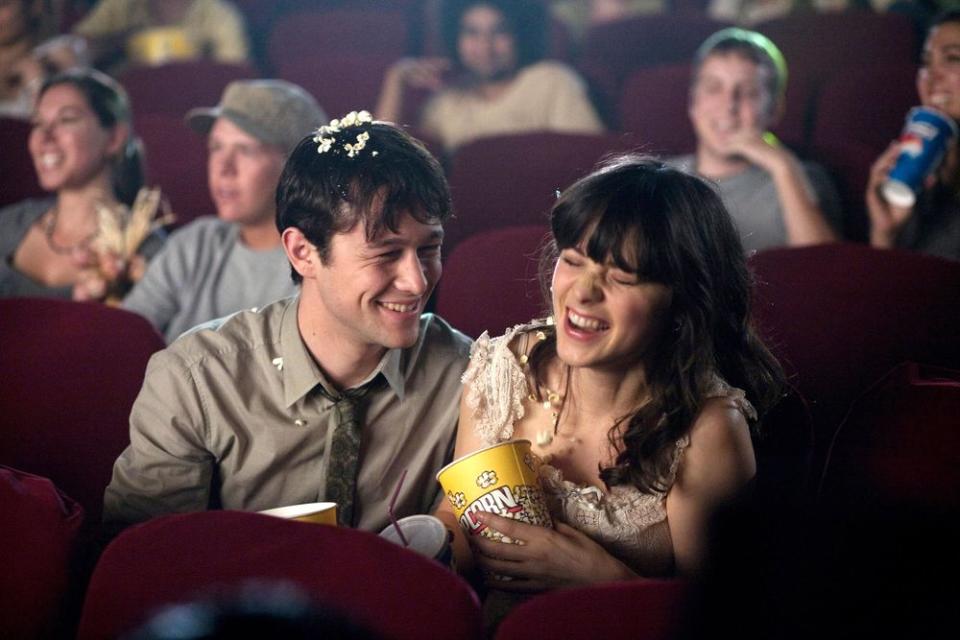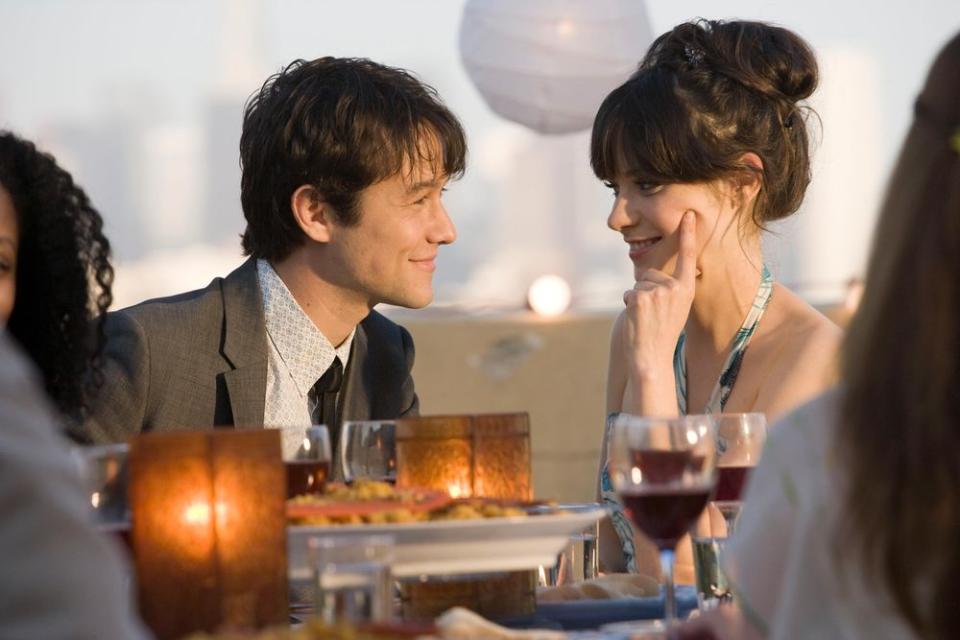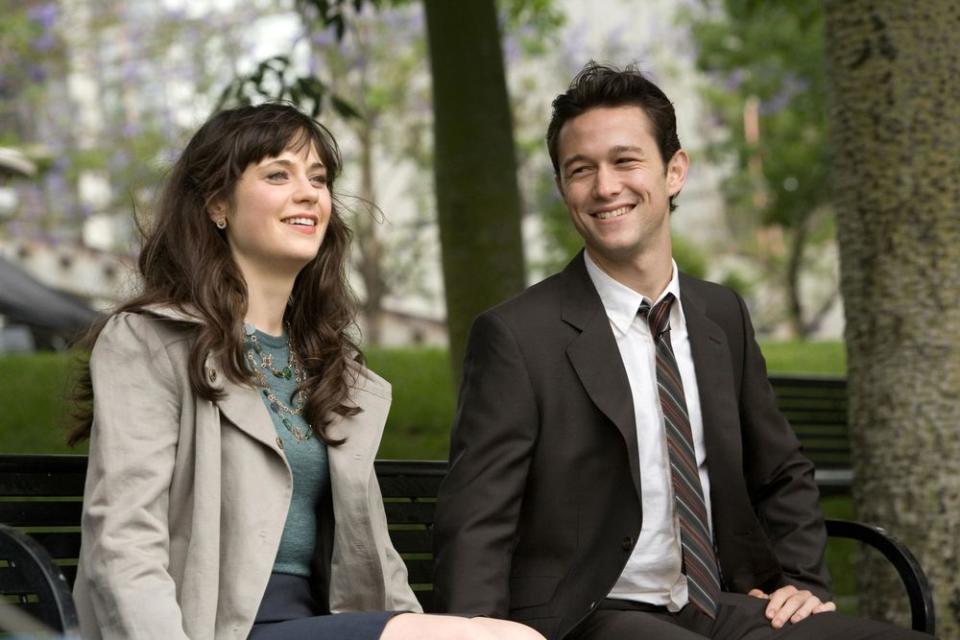The story of (500) Days of Summer, from its writers and director
It’s been over 3,600 days since (500) Days of Summer premiered in 2009, but we just can’t stop talking about it.
As part of our February rom-com extravaganza, we’ve been catching up with the cast and filmmakers behind the clever, insightful indie. Here’s what director Marc Webb and screenwriters Scott Neustadter and Michael H. Weber had to say about the film, from its inception to its Sundance premiere, after 10 years of (500) Days.

BASED ON A TRUE HEARTACHE — AND A ‘WEIRD CANADIAN MOVIE’
The story of the film began, as so many stories do, with heartbreak. Neustadter and Weber, then at the beginning of their careers, had long wanted to write a romantic comedy together, “but the early aughts were definitely not prime time for those,” Neustadter recalls. “All of our favorite movies are relationship stories. When they’re good, they’re the best, but they hadn’t been good in a while. We dreamed of one day writing our version of one of those.”
Then Neustadter’s relationship ended. “I was home, sort of reeling from that breakup. I did what I usually do in those situations, which is I just sort of drowned myself in music and in movies — exactly what the character does in the movie,” he says. “I had rented this movie called 32 Short Films About Glenn Gould. It’s this weird Canadian movie that I actually still have never seen, but I had the DVD on my DVD player, and I was looking at it and I realized: That’s a cool way to tell a relationship story, like a bunch of short films, and you can kind of tell them out of order, you can juxtapose them any way you wanted. I quickly sort of compiled this email to Weber saying, ‘I think I figured out our rom-com.’”
NOT A LOVE STORY
The narrator warns us, as the film begins, that what’s about to follow isn’t a love story. But that doesn’t mean it isn’t a romantic comedy. “Sometimes people have identified this as, like, an anti-romantic comedy because of the way that the movie ends, but I’m not anti-romantic comedy,” says Webb. “Romantic comedies can be incredibly subversive. I mean, Nora Ephron was identifying a modern situation and analyzing it, breaking it down, and creating an un-cynical understanding of how people behaved in a really beautiful way when she was doing When Harry Met Sally…What [she was] doing was incredibly progressive and really thoughtful.”
Neustadter and Weber’s affection for the genre resulted in an original take on it, a rom-com deconstructed and then lovingly rearranged. “We’re structure and device nerds; we like telling stories in unconventional ways,” Weber says. “The secret sauce, in some ways, is that memory isn’t linear, and the way you look back on things, it jumps around. You look on things in different ways, so the fact that we could have a kitchen-sink approach to all these devices, it really mirrored the way anyone looks back on an important time in their life.”
The script evolved over the course of a year-plus, ballooning into an approximately 150-page behemoth with “the longest first act in screenplay history,” Neustadter says. They were stuck on how to tighten it, but they got the answer when [spoiler alert!] the girl who had broken Neustadter’s heart got engaged. “Without that I think we might have continued to be struggling and lost,” he admits.
And while the central couple doesn’t end up together, isn’t the film hopeful — and even still romantic — because of the impact each of them has on the other? “We hate happy endings, because they don’t feel realistic, but we’re not doom-and-gloom where we want to lean into sort of awfulness, either,” Neustadter cedes. “We wanted the hopefulness, but we also wanted ambiguity. So there’s an element at the end where, did he figure it out? Is he going to make all the same mistakes again, or has he learned from this experience?”
“It was a coming-of-age story in a real way. The movie is very intentionally told from the perspective of the guy, and we wanted to identify his shortcomings,” says Webb. “He wasn’t observing the inner life of the Summer character. He projected on her, and I think that was something that is a very natural impulse for all of us, and that’s often masqueraded — we think of that as romantic, but really it’s just intellectual laziness.” (Sidenote: The film’s stars agree with this assessment.)

WAITING FOR A GREENLIGHT… STILL
Webb pursued the script for “probably a year” before he was hired to the project, and even then it was a fight to move forward. “I would plague [Fox Searchlight] with storyboards and presentations and ideas and animatics sort of on a weekly basis to try go get them enthused, and then slowly they started saying yes,” he says. “But I joke to my friends [that] the movie still hasn’t been greenlit. There was never a moment where they were like, ‘You’re making this movie!’”
But somehow, at some point, they were making it, and they needed leads. “For a while, there were a lot of actresses who were circling it, who would always say, if you flipped the perspectives and you made it a female — you made Tom a woman, basically — then they would be more inclined to dive in,” Neustadter says. “That was not something any of us wanted to do, so the script was sort of languishing.”
Webb met Joseph Gordon-Levitt on a meeting, “and I asked him who he thought Summer was, and without missing a beat he said Zooey [Deschanel]. And we ended up hiring Zooey first and then very quickly thereafter hiring Joe,” the director recalls. “There’s something about both of them that feels real. I thought that was important to make the film accessible. I really believe you can’t just cast a person; especially in a situation like this, you have to cast a chemistry, you have to cast a dynamic, you have to cast two people that work well together.”
“I think we were very lucky that the leads were two actors,” Weber says. “I think it’s a very different movie if it was two comedians. They were really playing for emotion in every scene, and I think that’s one of the reasons it turned out the way it did.”
A TRIP TO IKEA
The film may have been inspired by Neustadter’s real failed romance, but his wasn’t the only heart on the screen. “Every single person involved in this movie, I think, contributed some anecdote or something that appears,” he says (including, for one, the awkward copy-room kiss, which is something that once happened to Webb). For another, Summer and Tom’s two trips to IKEA — one tense and one playful, edited together but chronologically apart — were taken from Weber’s romantic history.
“I went to an IKEA with my girlfriend at the time, and when we were there the first time, it was fun; we were playing house,” Weber explains. “In the writing of that scene, it always felt a little bit like when they’re playing in the empty house in Rebel without a Cause — sort of younger people pretending to have a grown-up future. And then of course, they’re back there many months later, sort of on the backside of the relationship, and it’s a very different experience. It’s no longer fun and joyous.”
“It was one of the first things we talked about when we were putting pieces together. You can go on a date somewhere in the beginning, on the way up the mountain, and then you can go back to the same place on the way down the mountain but it’s completely different,” Weber says. Of course, “in most movies, those scenes would be an hour apart.”
When the day came, Webb’s experience at IKEA was decidedly not fun and joyous. “We shot when IKEA was closed, overnight, and I came back and I just didn’t think that we had gotten it,” he recalls. “I went home and I threw up, I was so nervous. I was like, this is not going to work — and it ended up being one of people’s favorite scenes in the movie.”

EXPECTATIONS VS. REALITY
The juxtaposition of those two IKEA scenes plays into the film’s parenthetical motif (reflected in its very title, among other places). The most pointed variation on that theme, however, has to be Webb’s use of split-screen, first in the opening credits, and later in the brilliantly effective “Expectations vs. Reality” sequence, the film’s three-and-a-half-minute thesis statement. The now-beloved scene was added to the screenplay after Searchlight had already optioned it. The studio gave the writers a note (their only note, for the record) that the script needed a fakeout — one last glimmer of hope that might trick the audience into thinking Summer and Tom will get back together. So they added the train ride, the wedding, and the rooftop party that brings it all tumbling down.
“It was an idea that I had had a little bit ever since I was in college, and every Friday night would be like, I get dressed and ready to go to the party, and I had a vision of what the night was going to be like, and it was always so awesome, and two hours later I’d be in my room listening to The Smiths,” Neustadter says. “That happened every single Friday!”
The dream of Expectations finally gives way to crushing Reality with a door closing on imaginary Summer and Tom. “I had a piece of fishing line to pull the door at the same rate that the [camera was] panning in the other half of the screen. I can still feel the fishing line digging into my knuckle as I was pulling it back — but it was so satisfying,” Webb recalls. ““I remember people suggesting that I cut to the full screen, but that felt violent to me!”
DAYS OF AUTUMN
We know the fate of the film’s central love story. But what about the couple it teases at the end? All three filmmakers have different takes on what’s next for Tom and Autumn. Weber’s view isn’t too rose-colored, but he’s still hopeful that Tom will grow: “I think it’s fun to think he makes all new mistakes on the next relationship,” he says.
For his part, Webb paints a charming picture: “They would have opened an architecture practice together,” he envisions. “I think Autumn designs the buildings and Tom does the interior decoration, probably, for Autumn.”
And Neustadter, whose own love life got everyone here in the first place? “I’m going to have to take the super-positive element of that, because I’m married with kids,” he says. And better yet: “I met my wife because she read the script. We had a general meeting, because she wanted to know who wrote this script. And we met and we’ve been together ever since. So this thing that was written to exorcise these demons did turn into kind of a life-changing experience for the positive.”

YEARS OF SUMMER
January 17 marked the 10th anniversary of (500) Days’ premiere at the 2009 Sundance Film Festival — a milestone that shocks all three filmmakers. Unlike Summer and Tom’s relationship, however, they agree that the timing was perfect.
“It was a movie about a tenderhearted male protagonist falling in love, and the stakes of the movie were so small, and I just don’t know if that would fly these days,” Webb says. “I think the movies that are made [now] have to create in the audience a real profound sense of urgency or sense of importance.”
If it were to happen today, anyway, it probably wouldn’t be from Neustadter and Weber (who were Oscar nominees a year ago for The Disaster Artist). “I wonder if we would take the same risks now, because we generally nowadays write movies specifically for an actor or a studio or a producer,” Weber says. “I think the movie benefited from us not fully knowing what we were doing and not knowing all the rules and not being a part of the industry yet. There was something very freeing that we probably didn’t even know that was on our side then when we thought it would never get made.”
Looking back on the Sundance premiere, Neustadter gets a little choked up. “We were proud of it, we were excited, but we were real nervous that it was not going to be received well,” he says (it was; they got a standing ovation — and an A from EW!). “It’s such a personal movie, for me anyways, that it really was one of the best memories I ever had.”
“It really was a romantic time for everybody,” Webb says of himself, the writers, and the stars alike. “It gave all of us so much, and I am in debt forever to all of those people because of that.”
For more Untold Stories from My Best Friend’s Wedding and your other favorite rom-coms, pick up the new double issue of Entertainment Weekly on stands Friday, or buy it here now. Don’t forget to subscribe to EW for more exclusive interviews and photos — and follow #LoveEWstyle on Twitter and Instagram.


